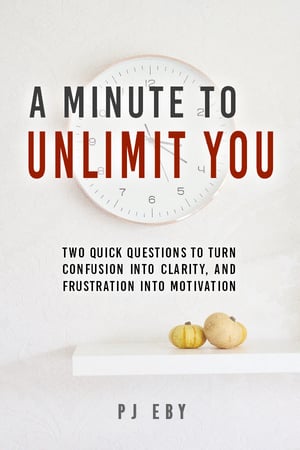When I was a kid, my first bicycle was a one-speed. Instead of hand brakes, you stopped it by pedalling backwards. Later on, I had some trouble adjusting to a 3-speed bicycle, because I kept trying to stop by pedalling backwards.
And I always wondered, why they bothered to have the pedals even able to turn backwards. After all, it’s not like pedalling backwards does anything.
And I used to wonder the same thing about a book I read when I was about 11 or 12 years old.
The book was called “Psycho-Cybernetics”, and it claimed that our brains included both a “success mechanism” and a “failure mechanism”.
Now, I could easily buy the idea that God or nature could have put a mechanism in our brains to help us succeed…
But why include a failure mechanism?
For nearly thirty years, that idea made absolutely no sense to me. Indeed, the more I learned about evolution, the less sense it seemed to make. The idea of having a “failure mechanism” seemed about as useful as pedalling backwards on a 10-speed bike.
But as it turns out, our brains are actually a lot more like my first bicycle.
Because pedalling backwards – i.e., the “failure mechanism”, is actually how you make it stop.
So it’s really just the names of the two mechanisms that confused me. If the book’s author had called them the “acquisition mechanism” and “protection mechanism”…
- Or the “leader mechanism” and “follower mechanism”…
- Or the “offense mechanism” and “defense mechanism”…
- Or the “creation mechanism” and “preservation mechanism”…
- Or the “pursuit mechanism” and “escape mechanism”…
- Or the “pleasure mechanism” and “anti-pain mechanism”…
- Or the “opportunity mechanism” and “threat mechanism”…
I might have understood it a lot sooner!
You see, every animal in its natural state requires both of these systems, and their operation is governed by a simple, but iron-clad law:
In the presence of a perceived threat, the threat mechanism is AUTOMATICALLY activated. In the presence of perceived safety, the opportunity mechanism MAY BE ALLOWED to activate.
So think about that for a second. Suppose a tiger twice the size of your desk suddenly charged towards you right now, leaping towards your face.
Would you think about what to do next?
Or would you already be running or diving for cover before you even knew what was happening?
Yeah, I thought so.
So the reason Dr. Maltz (the author of Psycho-Cybernetics) called this subsystem the “failure” mechanism, is because in modern life…
Most threats are imaginary!
And as a result, we’re always running and diving for cover… even from our goals!
Because if you even imagine a threat, or remember pain, your defenses can automatically kick in.
And procrastination, lack of “motivation” or “willpower”, fighting yourself, and inability to follow through, are all just symptoms of this defense system kicking in.
Worse, you can’t stop these symptoms by trying to!
Why?
Because that would simply mean…
You see them as a threat!
And that, ironically enough, just locks your brain deeper into protection mode!
You see, the goal of protection mode can be phrased fairly simply: “make the best of a bad situation,” or maybe “try not to lose too badly”. And its rules work roughly like this:
- If the threat is nearby and inbound, duck and cover, or run like hell
- If the threat is still at a distance, freeze and try to look like a rock or tree or something
- If the threat is a human of my tribe, placate or threaten it according to its relative status in the pecking order
And if you look at those rules closely, you’ll see where a lot of self-defeating behavior comes from… like procrastination (freezing when the threat’s at a distance).
And you can’t switch this machinery off… which is a good thing. After all, if a tiger really burst into the room right now, you’d need the “duck and cover or run like hell” part to kick in.
You can try to override it by sheer willpower, but that only works for a short time. Think about it: willpower is something you use to override your evolved instincts. That means that if there was some evolutionary benefit to doing that all the time…
You’d have evolved different instincts!
So willpower is implicitly designed to be temporary. (And no, I’m not implying the existence of a designer or ascribing “goals” to evolution.)
And, as scientists have found in experiment after experiment, willpower is a very limited resource, that is depleted by almost any kind of stress.
Like the stress of using willpower, for example!
Now, there is some evidence to suggest that concentration and willpower can be trained and exercised by meditation, actually causing new brain growth to support the enhanced ability. But there’s not a lot known about that yet, and in any event, it takes time, just like any other form of exercise.
So, willpower is definitely not a quick fix for the backpedalling of the failure mechanism. Luckily, however…
Nature Left Us A Loophole
You see, the threat-response system or “failure mechanism” is triggered by detection of a “threat”. However, the response system is not responsible for defining what consitutes a threat.
You are!
Well, not exactly. It’s your memories, beliefs, and imagination that define threats. And this can include things you saw in the movies, heard in a story, picked up from parents and peers, had happen to you, etc. So your “threat portfolio” can contain an awful lot of stuff that you never consciously decided to put there.
But you can clean that stuff up, as my work on myself and my clients has shown. You can “declassify” things as threats, thereby ramping down fear and avoidance responses. You can delete imagined negative futures, and shut down and reroute your pain-avoidance beliefs and behaviors.
You can, in other words, turn every threat you face… into “no big deal”.
And if you want to live a fulfilling life, it’s incredibly important that you do so. Because the problem with the “failure mechanism” is that it’s all about avoiding losing.
Which Is Not The Same As Winning!
You see, when you’re trying to avoid loss, you don’t take risks. You don’t invest as much. You don’t commit to taking action.
In short, you duck and cover, in the hopes of minimizing the pounding you’re going to take.
But to actually win at anything, you have to put yourself out there. Expose yourself to pain. And be willing to pay the price.
And that will never happen while you’re in “failure mode”.
Unfortunately, most self-help material completely ignores this basic fact, choosing instead to focus entirely on the “success mechanism”, and the best methods for exploiting it. Even Psycho-Cybernetics (whose author at least acknowleged the existence of the failure mechanism, as few others do) had very little to say about how to turn it around.
That’s why I’m doing a workshop this weekend called “The Art Of The ‘No Big Deal’”, to share with you the wealth of things I’ve learned about the failure mechanism. Including how it works, and how to circumvent it.
So you can stop backpedalling.
And start living.
–PJE
P.S. The workshop is a conference call that will be held on Saturday, February 16th, at 3pm Eastern time, and you must be an Associate or Full member of the Circle in order to participate. If you bought my Procrastination Cure course in the last few weeks during one of my special promotions, then yes, your trial month of Associate membership qualifies you to participate.










PJE,
You said something great here, and I'm letting it sink in. New to some of this, I've been wondering how to leverage the pain-pleasure dichotomy for some time now. I tried A.Robbins's first book, but too much hand-waving. Psycho Cybernetics looks good.
Anything else you'd suggest?
The two books I most recommend right now are "Loving What Is" by Byron Katie, and "Embrace The Unlovable" by Amyrah Mah.